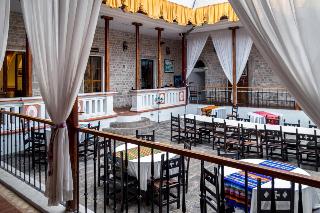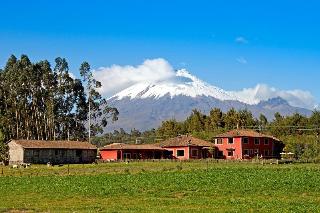Find hotels in Latacunga
Lowest prices detected by AI for hotels
Best
Cheapest
Star Ratings
AI Recommended
Best Hotels In Latacunga
Cheapest Hotel Deals in Latacunga
Top Rated Hotels
5 Star Hotels in Latacunga
3 Star Hotels in Latacunga
AI-recommended Destinations
Where to stay in Latacunga
More About Latacunga
Latacunga (Spanish pronunciation: [lataˈkuŋɡa]) is a plateau town of Ecuador, capital of the Cotopaxi Province, 89 km (55 mi) south of Quito, near the confluence of the Alaquez and Cutuchi rivers to form the Patate, the headstream of the Pastaza. At the time of census 2010 Latacunga had 98,355 inhabitants, largely mestizo and indigenous.
Latacunga took its independence from Spain on November 11, 1820.Latacunga is an hour and half south from Quito on the Pan-American Highway. It was previously also on the old road from Quito to Guayaquil, and has a railway station between those cities. It is 9,055 ft (2,760 m). above sea level. Its climate is cold and windy, due to the neighboring snowclad heights, and the barren, pumice-covered tableland on which it stands. The active volcano Cotopaxi is only 25 km. away, and the town has suffered repeatedly from eruptions. Founded in 1534, it was four times destroyed by earthquakes between 1698 and 1798. The neighboring ruins of an older native town are said to date from the Incas Empire.
Latacunga's most noted food is chugchucaras, empanadas, plantains, popcorn, and tostado (a type of toasted corn.) Often mixed with ají, a type of condiment that can be mild to very spicy depending on how it's prepared.
The Latacunga economy is dependent on agriculture, floriculture and commerce. It has an international airport, the Cotopaxi International Airport, that is not used for international passenger use, but as an Air Force base and some special commercial flights. The local volcanic activity has led to the accumulation of pumice deposits which are currently mined, as well as the presence of natural sparkling water, which is bottled under the brand name San Felipe.
The airplane scene in the film Maria Full of Grace was filmed out of the Latacunga airport using local extras. The landscape seen from the plane is the area surrounding Latacunga.
 Time UTC-05
Time UTC-05 Currency USD
Currency USD Languages Spanish, Quechua, Ameri-indian languages
Languages Spanish, Quechua, Ameri-indian languagesWhat’s Special about Staypia?
Compare hotel prices in real-time
AI finds you the lowest price for hotels in Latacunga.
Lowest price for 3.16M hotels worldwide
Book with up to 31% extra discounts only for Staypia members.
Travel bucket list for Latacunga
Plan your trip with over 17K 'must see' recommendations for Latacunga
Frequently Asked Questions
The best 5 star hotels in Latacunga are Hotel Joshed Imperial. Search for the most highly rated hotels in Latacunga
Generally, room reservations are subject to a free refund until the cancellation deadline. Fees may apply after the cancellation deadline, so please check the cancellation deadline on your hotel voucher or in Menu > My Reservation.
If you’re a frequent traveler, Staypia is the best place to get the best hotel deals. You can book hotels with the lowest price of 3.16 million hotels collected by AI, and receive additional discounts for members only.











